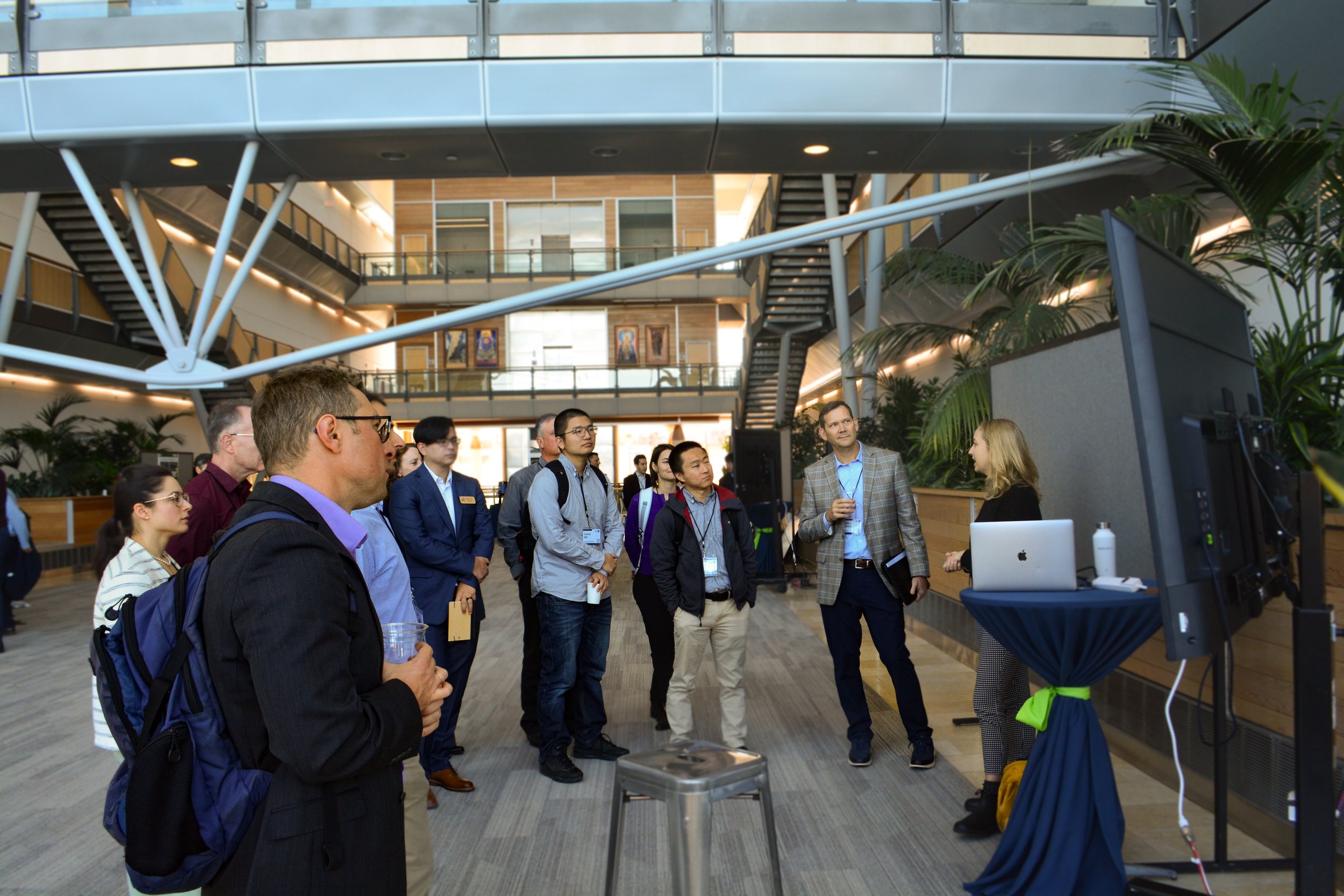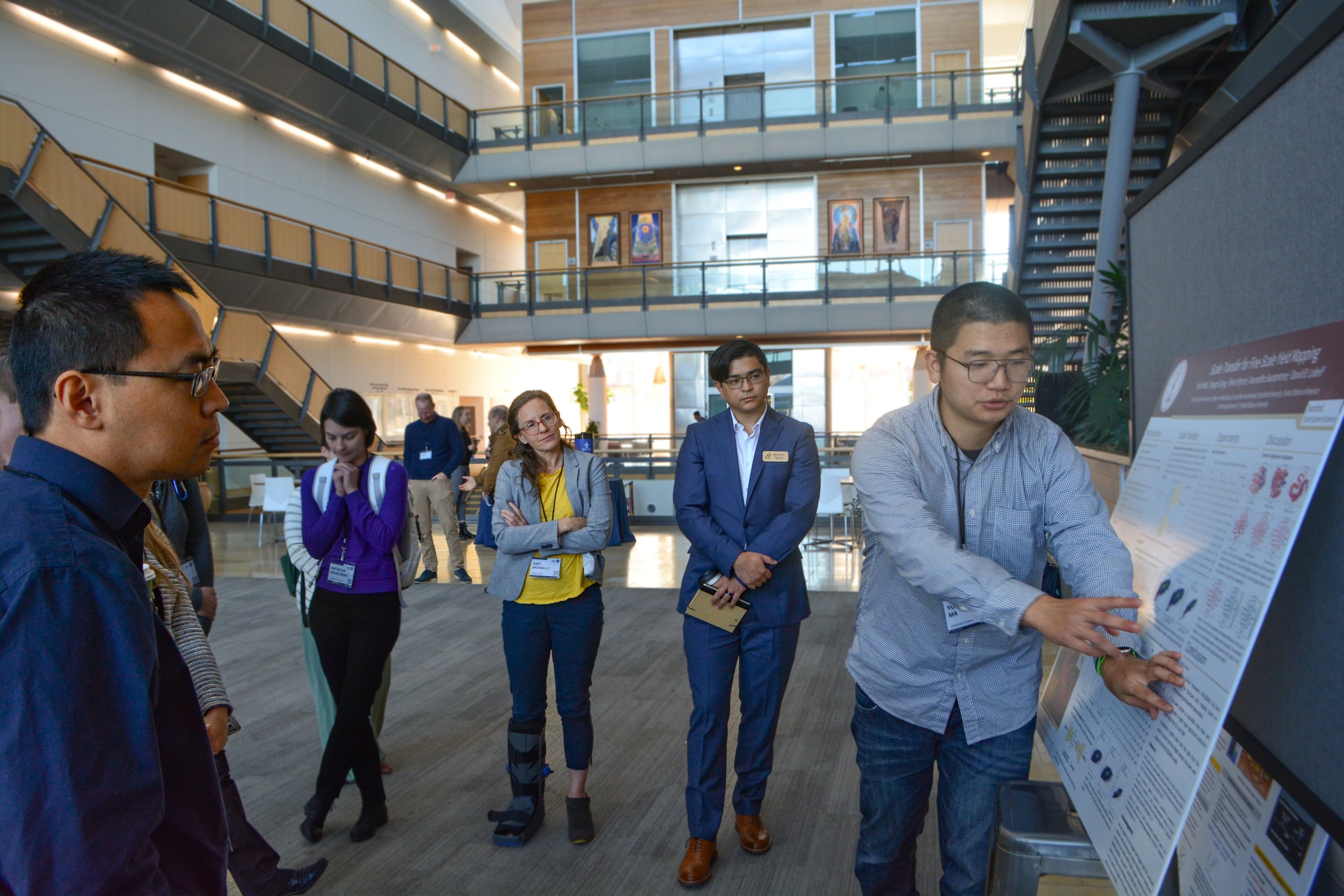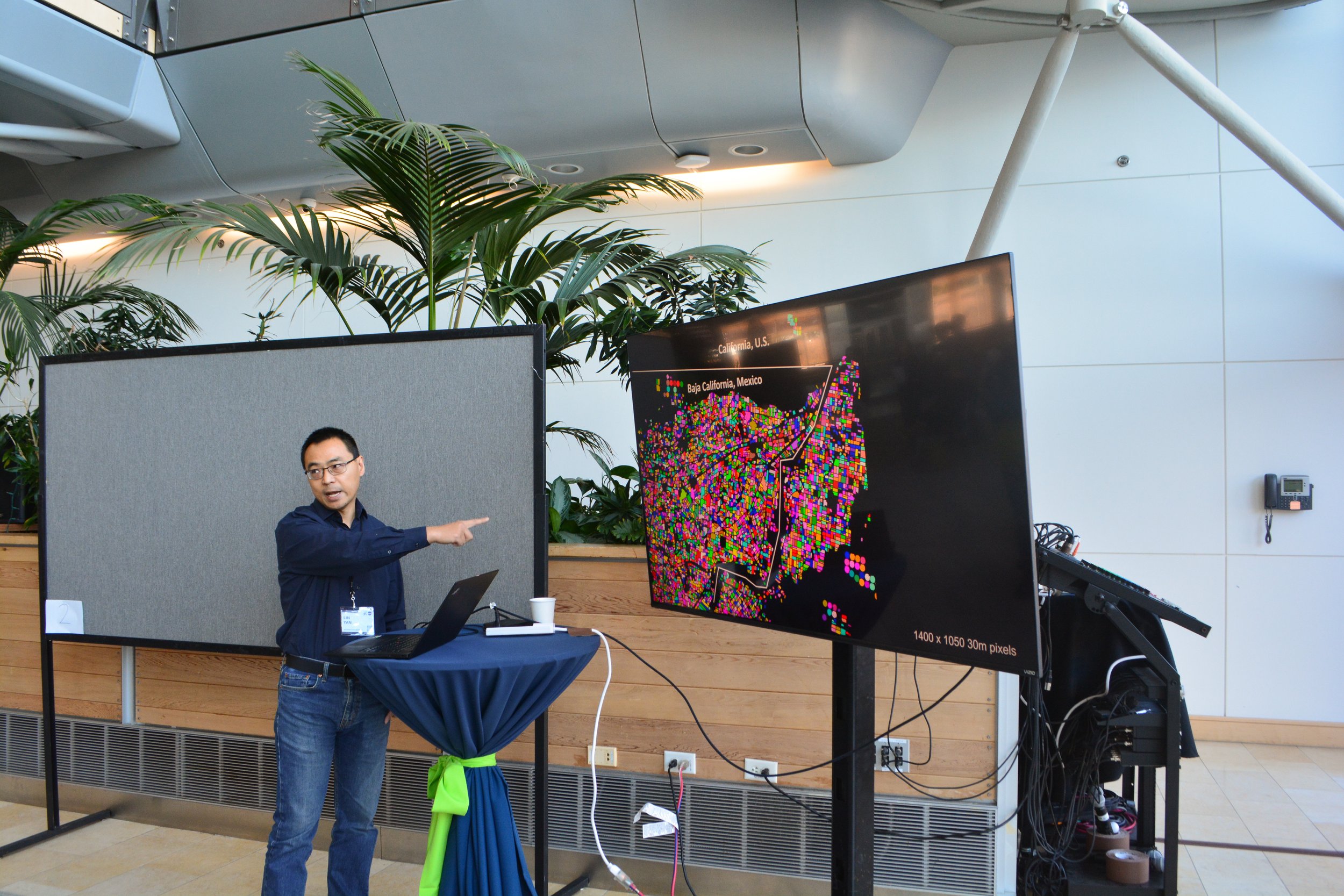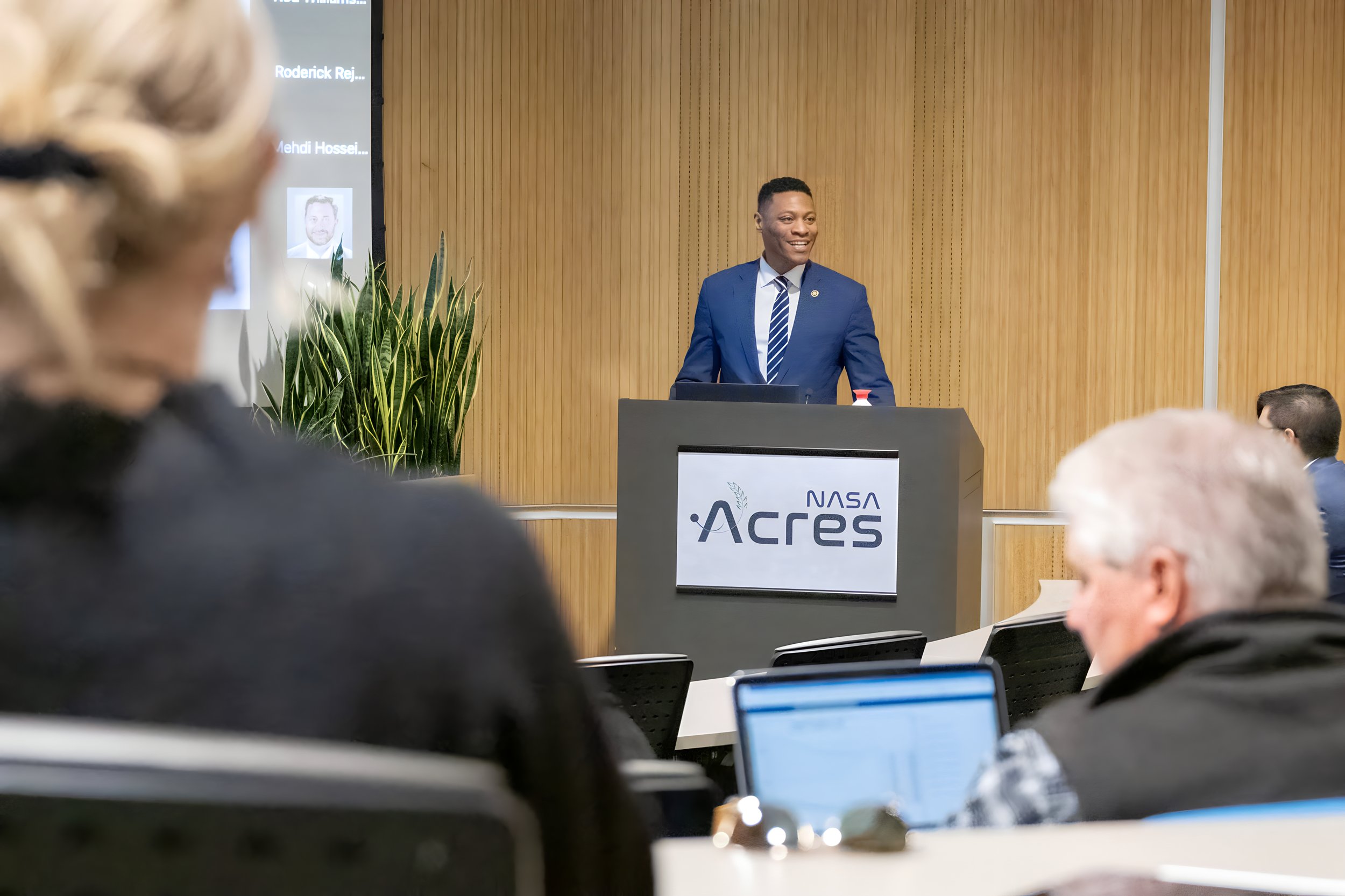Over 40 organizations joined NASA Acres in St. Louis for a Kick-Off Meeting, marking its official launch
November 13, 2023 - Written By Nicole Pepper
Image: NASA Acres Kick-Off Meeting Attendees gather in front of the Donald Danforth Plant Science Center in St. Louis, Missouri
On November 2 and 3, NASA Acres hosted our inaugural Kick-Off Meeting at the Donald Danforth Plant Science Center in St. Louis, Missouri, gathering Consortium partners and collaborators from over 40 organizations with a shared commitment to supporting national agriculture and food systems using satellite data and technology.
NASA Acres is NASA’s new Consortium focused on agriculture and food security in the United States of America (U.S.). We are focused on improving and extending methods that utilize satellite data to efficiently meet the growing demands, stresses, and challenges facing our domestic agriculture and agrifood system. As the first Consortium-wide gathering, the Kick-Off Meeting served as an important milestone for aligning on programmic goals, identifying gaps and opportunities, and prioritizing next steps.
The Consortium includes more than 25 funded Research, Development, and Extension (RD&E) Partners who bring expertise in agricultural remote sensing, machine learning, social science, agronomy, rangeland science, sociology, economics, and data policy, among other disciplines, to their projects and to the Consortium as a whole. Also joining the event were Collaborator Partners from across the agriculture and Earth science domains with a common interest in harnessing the power of satellite data for on-farm and broader agricultural applications.
The work of NASA Acres is intended to build a wider foundation for satellite data to positively impact agriculture in the U.S. and its role world-wide. “Reaching impact for us requires a human touch. We need to be collaborative,” said Dr. Alyssa Whitcraft, Executive Director of NASA Acres, and a Research Professor at the University of Maryland. “When we do this it creates more space for innovation and improves the state of science, even if we aren’t the ones directly producing an output or product.”
Dr. Karen St. Germain, Division Director of NASA Earth Science Division, and Dr. Bradley Doorn, NASA Water Resources and Agriculture Program Manager, opened the Kick-Off meeting with an explanation of NASA’s decades-long involvement and continued investment in agriculture. “Today, we have 26 missions in orbit around the Earth,” said Dr. Germain. Historic and recent innovations in satellite Earth observation (EO) technology is allowing us to grow our understanding of agriculture from space in new and innovative ways. “Working with the agriculture sector,” added Dr. Germain, “lets us identify opportunities to turn our Earth Science Data into action, informing decisions made by farmers and ranchers who know that they are getting the best science available.”
NASA Acres RD&E partners share research initiatives and forge paths for cross-consortium collaboration
The Consortium is focused on improving the quality of satellite-based methods to measure and map core variables of land use and productivity, to use those variables to better understand the state of agriculture in the U.S. as well as the interplay between different management practices and agronomic and environmental outcomes, and to use the methods, maps, and advanced understanding to help farmers and ranchers, their advisors, and the companies they work with improve decision-support systems and tools.
Image: Digram explaining the NASA Acres workflow and framework that we have set forth to achieve our mission
“The development of Essential Agriculture Variables (EAVs) are the key building blocks to produce relevant and timely information and knowledge for, by, and with NASA Acres,” explained Dr. Whitcraft, adding, “If we can do this, we will raise the bar on overall quality of agriculture applications that use satellite data - and that’s a win-win for everyone invested in the U.S. food system.” Examples of EAVs that the Consortium has identified include within-season yield forecasts, historical yield estimation, cropland and crop type mapping, crop planting and harvest dates, and rangeland productivity, among others.
We consider our RD&E partners as our “doers” or implementers of this framework. At the meeting, our RD&E partners came together to discuss their current and planned research in a ‘Crop Circles' activity, where small-groups rotate, round-robin style, to view partner presentations in a format designed to promote intellectual exchange. These discussions provided time to identify new and synergistic opportunities for collaboration across-Consortium.
Image Left: Dr. Hannah Kerner, far right, presenting during the Crop Circles session
Image Center: Dr. Yuchi Ma presenting at the Crop Circles session
Image Right: Dr. Lin Yan presenting at the Crop Circles session
Project highlights from our RD&E partners include Dr. Hannah Kerner’s work at Arizona State University on satellite enabled artificial intelligence for food security in Maui as well as Dr. Yuchi Ma’s research at Stanford University on improved methods for fine-scale yield modeling, and Dr. Lin Yan’s work at Michigan State University on developing high-resolution crop field boundary extraction methods and products.
Insights from Missouri agriculture
66% of Missouri’s Land is in agriculture. Wanting to take advantage of our presence in this major agricultural state and St. Louis’ prominent geospatial expertise, NASA Acres gathered insight from key perspectives in the region.
Senator Brian Williams, of the Missouri Senate, joined the opening session to welcome the group and discuss how state efforts would benefit from the mission of NASA Acres. “This is incredibly important because the Missouri farmers work hard to feed our nation, and by helping them we can help families put food on the table,” said Senator Williams, “NASA Acres will ultimately help feed families, and Missouri is proud to partner in this effort.”
This was followed by a panel that asked, “How Can the Agriculture Technology Industry and NASA Acres Support One Another’s Missions?” Dr. Whitcraft moderated the panel composed of experts including Dr. Steven Rosenzweig, Agriculture Lead Scientist of General Mills, Mark Baxa, CEO of the Council for Supply Chain Management Professionals, Dr. Vasit Sagan of Taylor Geospatial Institute, and Chancellor Dr. Kristin Sobolik of University of Missouri - St. Louis. The panel emphasized ways that organizations in the private sector and across the value chain can work synergistically with NASA Acres to achieve our mission.
Image Left: Senator Brian Williams of the Missouri Senate during his welcome address during the opening session. Photo by Derik Holtmann, University of Missouri-St. Louis
Image Right: From left, Dr. Vasit Sagan, Dr. Steven Rosenzweig, Mark Baxa, and Kristin Sobolik speaking on the agriculture technology panel during the opening session. Photo by Derik Holtmann, University of Missouri-St. Louis
“I’m excited for this opportunity at NASA Acres because I think it can connect those developing tools with those of us on the other end that need to be able to use those tools to make claims about impacts, to understand what kind of changes we are driving,” said Rosenzweig, “And also, I think it needs to go back the other way. There are so many projects now hitting the ground and this is a huge opportunity for data collection and advancing science, but unless we are coordinated it’s going to be everybody doing these individual projects in their own silos in these black boxes.”
Much of the discussion was centered on the value and necessity of collaboration. Sagan presented the question of how these groups can create impact where our farmers can benefit the most. “We have to produce 70% more food by the next several decades. We have limited resources: land, water, and how do you do that,” posed Dr. Sagan, “The only way is to rely on technology, partnership, and only then we can succeed.”
Bringing the benefits from space to farm means first linking farm data to space
While satellite data is an incredibly useful tool for studying Earth systems, there are practical limitations to looking at crops from a 705 kilometer (438 mile) vantage point, the altitude of Landsat’s orbit. Farmer data plays an important role in providing researchers with on the ground information that is necessary to train computer models on identifying patterns and impacts in satellite imagery. Many farmers across the United States already use practices and machinery that collect a tremendous amount of data about their farms. At the meeting NASA Acres presented a roundtable discussion on “Digital Agriculture, Data Governance, and Privacy” featuring Dr. Steven Wolf of Cornell University as the guide for discussants including Todd Janzen of Janzen Schroeder Agricultural Law and Ag Data Transparent, Rebecca Bartels of Trust in Food - Farm Journal, Laura Gentry of Illinois Corn Growers Association, and Lance Lillibridge and Jason Orr, both farmers in Iowa.
Dr. Wolf framed the discussion around identifying social opportunities, costs, and potential issues in the use of data for research and the development of tools. “Researchers working to analyze agriculture dynamics and develop new tools for agriculture management will benefit from being introduced to social and economic concerns that have proven to be sticking points in creating value for farmers and other value chain actors engaged in digital agriculture,” said Dr. Wolf.
One of the biggest sticking points: farmer skepticism and general confusion regarding data privacy and sharing. There is concern from the farming community that without proper protections, once farm data is shared it could be used in ways that do not align with its original intention or it could even be used against them. “Farmers are dollar and cents people. Over the past 40 years commodity prices have gone up and down”, shared Orr. “Everyone wants our data. If you want my data, what do I get out of it?” Value is key, Gentry would argue, “farmer data has intangible and inexhaustible value.”
Image: From left, Dr. Steven Wolf, Rebecca Bartels, Jason Orr, Lance Lillibridge, Laura Gentry, and Tod Janzen serving on the panel discussing digital agriculture
Much of the discussion was centered on the principles of data governance. Janzen grew up on a farm in Kansas and is a top lawyer in U.S. agriculture who also serves as the Administrator of Ag Data Transparent project, a national effort to bring transparency to contracts between farmers and technology providers. Janzen and other members of the Consortium will leverage this experience to support the development of data governance guidelines for farmer data use in applied research and extension activities like NASA Acres.
“Our farms are our legacy,” said Lillibridge,”We want to share our information and we want to be better but we have to be careful with how we do that.”
Another key topic explored was regarding resource-efficiency and resiliency in the agriculture sector. Depending on who you are talking to, sustainability has a different meaning. When NASA Acres discusses sustainability, we are not just speaking about being resource-efficient but we are also talking about the sustainability of the economy and wider supply chain as well as supporting rural livelihoods, economies and jobs. Dr. Kaiyu Guan of the University of Illinois Champaign-Urbana and Chief Scientist for NASA Acres, led the group in a roundtable discussion on “Resource-Efficient Decisions, Policy, and Action” to explore the role that NASA Acres and satellite data plays in supporting our understanding of sustainability in agriculture. The discussants included Pamela Bachman of Climate LLC - Bayer Crop Science, Jack Cornell of United Soybean Board, Steven Rosenzweig of General Mills, and Michael Klein of USA Rice Federation.
Dr. Guan framed the discussion around identifying key challenges and gaps that exist in understanding and monitoring resource-efficient practices in the agriculture industry and what opportunities exist for satellite data to help. One of the major gaps identified by the group was confusion around baseline data and the definitions used for mapping and understanding cropland. Cornell noted, “that’s one of the big gaps that hopefully NASA Acres can help address… to really kind of help set some of the standards or baselines,” that are objective and robustly, publicly validated.
Image: From left, Jack Cornell, Pamela Bachman, Michael Klein, Steven Rosenzweig, and Dr. Kaiyu Guan speaking on a panel at the Kick-Off Meeting..
Another challenge is that farming practices vary highly and work differently in different places, and their impacts will appear differently depending on the geographic and time scale of analysis. Rosenzweig suggests that this is where satellite data and NASA Acres could provide support. “How do we monitor and verify impacts that farmers are making on their farms, so that we can really talk about the impacts of these regenerative agriculture systems or these new technologies that farmers are adopting? That’s where I think some of these tools can help,” posed Rosenzweig.
Bachman expressed concerns over the complexities of accessing and managing the vast array of data and tools that already exist, “How do we make EO data this public good, that is easily accessible, unlocked so that it can really drive the innovation.” Rosenzweig posed the importance of the Consortium in helping unite and organize projects throughout the group, so we aren’t duplicating efforts.
“I think it’s really important that NASA not privilege any one group or company or sector. I believe there is a way for us to bring value to almost every single actor in agriculture and do so in a way that is beneficial and reduces harm as much as possible. At the same time, I think that’s much easier said than done and I think we need to be intentional in how we approach that. To me, we stay focused on our principles, we disclose our definitions, and we articulate our sensitivities in advance,” said Dr. Whitcraft. She then charged all partners with the task of thinking about how they would approach these challenges in their work, and as it contributes to NASA Acres.
Our vision for resource efficient, productive, and resilient food system
The Kick-Off Meeting served as an important effort to nurture discussion around the gaps and opportunities for the Consortium though, importantly, several key existing partners as well as unengaged voices and perspectives were absent. We look forward to growing our collaboration and bringing in the voices needed to address the complex challenges and opportunities facing farmers and the broader agriculture industry.
Thank you to our event sponsors and supporters
Special thanks to the Donald Danforth Plant Science Center for their generous support and venue sponsorship of the event. We would also like to extend our gratitude to University of Missouri St. Louis (UMSL), Council of Supply Chain Management Professionals (CSCMP), and Bayer Crop Science for their generous sponsorship of the event’s social gatherings. Lastly, we express great gratitude to NASA Earth Science Division for launching NASA Acres.
About NASA Acres
Our mission is to bring the value of satellite data down to Earth. We bridge the gap from space-to-farm and education-to-impact together with U.S. farmers, ranchers, and other agrifood system decision makers who are charged with addressing the most pressing challenges to resource-efficient, productive, and resilient agriculture, both today and into the next generation. The Consortium is funded by the National Aeronautics and Space Administration (NASA) and led by the University of Maryland with Research, Development, and Extension Partners at nine other universities and two supporting private organizations. NASA Acres builds on the success and learnings of our sister Consortium focused on global food security and agriculture, NASA Harvest.
Website: nasaacres.org
Twitter: @AcresProgram
For media inquiries or more information, please contact:
Nicole Pepper
Communications and Outreach Coordinator, NASA Acres









